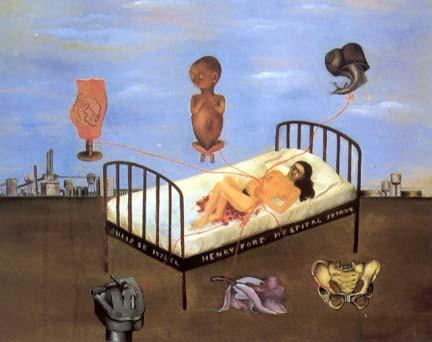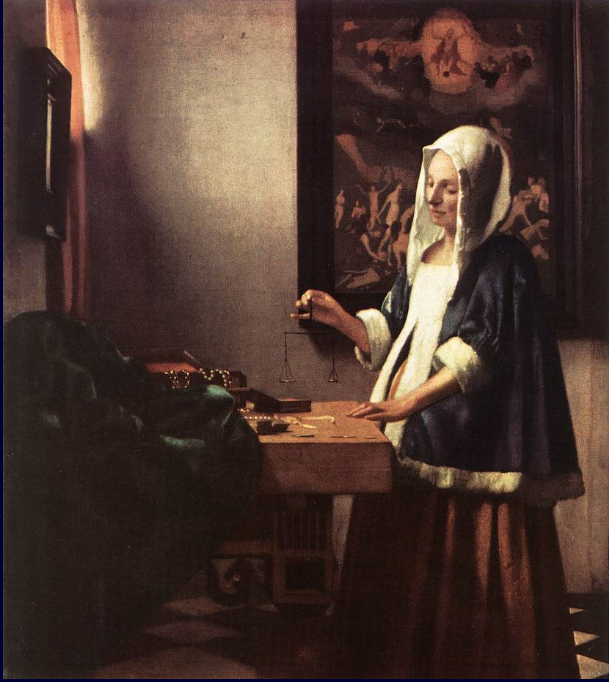When the works by Frida Kahlo, a Mexican painter of the twentieth century, were displayed in Europe, visitors highly appreciated them for their impressive dream imagery. However, Kahlo herself rejected this praise and argued that she painted not dreams, but her reality (Getlein 64). Kahlo’s Henry Ford Hospital is a self-portrait and a symbolic representation of the painter’s vision of reality (Kahlo, “Henry Ford Hospital”).
Another interesting example of the symbolic imagery used for depicting the character’s inner world is a painting Woman Holding a Balance created by a Dutch painter, Johannes Vermeer, almost two centuries earlier than Kahlo’s self-portrait (Vermeer, “Woman Holding a Balance”). This paper will compare and contrast the oil on a metal painting by Frida Kahlo created in 1932 and included into the Collection of Dolores Olmedo Patino in Mexico City with oil on canvas Woman Holding a Balance painted by Johannes Vermeer in 1664 and exhibited in the National Gallery of Art in Washington, DC. The inward look and depiction of human experience is a common theme uniting these paintings, Kahlo in her self-portrait and Vermeer in his painting of a beautiful woman used symbolic imagery to represent the inner world of their characters.
Although the first painting is a symbolic self-portrait and the other one is a realistic portrait of a woman, both of these works strike the audience with the powerful depiction of the women’s experience of suffering. Henry Ford Hospital is only one of Kahlo’s self-portraits which frequently included the imagery of numbness and grief expressions (“Pregnancy Loss and Visual Expressions of Grief”). Moreover, Henry Ford Hospital shows not only the theme of the lost pregnancy but also Kahlo’s depersonalized experience and enormous emotional distress as she felt that her body betrayed her (Clements, “The Origin of the World”).
The symbols surrounding the bed on which the woman lies offer insights into her life situation. Above the bed, there is a baby, she had been expecting. A pink female torso and a pelvis, which she broke in an accident, symbolize the physiological aspect of the problem which did not allow Frida to give birth to a baby. A large scary-looking machine shows the terrible experience of miscarriage and the experience of being in the hospital. The flower under the bed has a sexual connotation. One more important symbol is the woman’s blood on the bed which is one of the most powerful symbols depicting her pain and suffering (Codreanu, “Dynamics of Blood).
The theme of pregnancy is arguably raised in Woman Holding a Balance too (Getlein 64). The silhouette of the depicted woman offers the interpretation that she is pregnant. However, according to the explanations offered by Gregg, an expert working at the National Gallery of Art where the painting is exhibited, pregnant women were never portrayed at that time (Gregg, “Woman Holding a Balance”). At the same time, it was fashionable to be outfitted in layered clothes.
Although there is no definite to the answer whether the depicted woman is pregnant or not, more attention should be paid to the inclusion of the symbolic imagery of scale, the character hold in her arm, and the painting of the Last Judgment in the background. The inclusion of the ‘painting in the painting’ links Vermeer’s painting to the Christian iconography traditions (Glass, “Vermeer in Dialogue”).
At the same time, the act of balancing the empty scale is closely interrelated with the act of judgment depicted in the background painting. The viewers can hypothesize that the seemingly quiet woman, contrasted to the Last Judgment in the background has an inner conflict and tries to solve it by using the scale and looking for salvation in religion. Thus, regardless of the different symbols and motifs were chosen by the painters, both works strike viewers with the inward look into the human experience of suffering. Particular examples of contrasts in designs and creative decisions of Kahlo and Vermeer include:
Shape
Kahlo and Vermeer combined the natural curvy lines used for depicting people and objects of nature with sharp rectangular lines depicting the city, furniture, and other objects in the background. This contrast emphasizes the effect of alienation of people from their surroundings and focuses on their inner world. The organic lines of a bleeding woman, an unborn baby, and a flower in Henry Ford Hospital contrast with the large bed and the houses of the city. Similarly, the woman in Woman Holding a Balance is in contrast with the rectangular table and the frame of the picture in the background.
Space
Kahlo intentionally diminishes the size of the woman and depicts her from a distance to show how helpless and unprotected she feels in the hostile environment of the hospital. Vermeer, on the contrary, puts the woman in the forefront, leaving the rest of the details in the background. The main focus of the painting is on this woman and her inner world, while the painting of the Last Judgment in the background symbolizes the inner processes hidden behind her outer harmony.
Color
The artists used shades of brown and tan to show the atmosphere of the hospital and badly-lit room respectively. Kahlo used blue color for depicting the sky above the woman on the bed which might represent her appeal to heaven and the fact that she still has not abandoned hope. Vermeer uses shades and bleaks to show the light coming from the window.
Texture
Though Kahlo chose metal and Vermeer canvas, both artists used oil colors in their paintings which had an impact upon the texture of the paintings. Vermeer managed to depict the fur decorating the woman’s clothes. Importantly, the viewers can notice the difference between the textures of the coat, skirt, and headscarf that the woman is wearing. On the other hand, the texture is less important for the symbolic depiction of a naked woman in Kahlo’s self-portrait.
Balance
The equilibrium is achieved differently in these paintings. Kahlo’s painting is symmetrically balanced with the two sides of the bed balancing each other though the woman lies on only one of those sides. Also, the elements of symbolical imagery surrounding the bed are balanced too. Vermeer’s painting is asymmetrical. However, the woman’s hand holding the scale is in the center of the entire painting.
Emphasis and Subordination
The women are the central figures in both paintings. Through subordination, Kahlo depicted the city and symbolic imagery, and Vermeer depicted the painting of the Last Judgment in the background.
Directional Force
Although the woman is the focal point of Henry Ford Hospital, the eyes of the viewers are next driven to the fetus, because the unborn baby is put right above the bleeding woman, and being almost the same size as the woman, hangs in the air. The threads connect Frida with the fetus and other symbolic objects and show the direction for the viewers’ eyes. Vermeer lit the painting in the background to draw the viewers’ attention to the painting.
Repetitions and Rhythm
The repetitions are evident only in the bed and the houses of the city in the background in Henry Ford Hospital. These repetitions emphasize the fact that these elements are artificial. The whole painting is motionless with the symbolic objects and even the bed hanging in the air. In Vermeer’s painting, the objects are motionless too. Even the scale looks balanced and does not move.
The self-portrait Henry Ford Hospital by Kahlo and the painting Woman Holding a Balance by Vermeer are united by the same theme of inward-looking into the human experience. However, Kahlo and Vermeer who lived and worked in different countries and epochs chose different styles for developing these themes in their works. The objects of symbolic imagery linked by threads to the bleeding woman in Henry Ford Hospital as well as the painting of Final Judgment in the background of Vermeer’s painting reveal the inner processes in the souls of the depicted women.
Importantly, the artists used directional force for drawing the viewers’ attention to the most important symbolic objects. Both pictures are motionless because the main emphasis is put upon the inner life of the characters, whereas the surrounding is used only for background and depiction of the inner processes. The depiction of the suffering of women who try to find solutions and salvation strikes the audience, revealing the theme of human experience in their uniquely interesting manners.
Works Cited
Clements, Jessica. “The Origin of the World: Women’s Bodies and Agency in Childbirth.” Diss. George Mason University, 2009. Web.
Codreanu, Florina. “Dynamics of Blood in Frida Kahlo’s Creation.” Bulletin of the Transilvania University of Brasov. 2.51 (2009): 249 – 256. Web.
Getlein, Mark. Living with Art, New York: McGraw-Hill Higher Education, 2010. Print.
Glass, Marguerite. “Vermeer in Dialogue: From Appropriation to Response.” Diss. The University of Maryland, 2003. Web.
Gregg, Jessica. “Woman Holding a Balance.” n.d. Web.
Kahlo, Frida. “Henry Ford Hospital.” n.d. Web.
“Pregnancy Loss and Visual Expressions of Grief: An Examination of Frida Kahlo”. n.d. Web.
Vermeer, Johannes. “Woman Holding a Balance.” n.d. Web.
Appendix 1

Appendix 2
